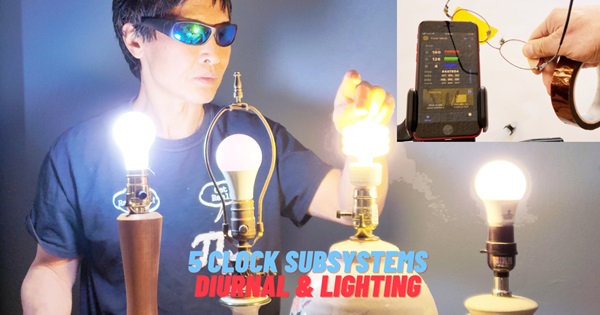https://youtu.be/A5B6v_zmS70 This video is part 2 of our Circadian Rhythms with 5 Clock Subsystems. It will continue to discuss how to resolve two problems:
- At what time we are more likely to fall asleep, and how to meet the necessary conditions for falling asleep.
- How to stay asleep longer.
So one problem is the starting point of sleep, the other is achieving a longer sleep duration. Part , https://youtu.be/biK34N4hnqM discussed the 24-hour Circadian Rhythm and the 90-minute Ultradian Rhythms. Today’s video is about the Diurnal Rhythm to mark the end of sleep and to calibrate your clocks so that the clock does not drift away. We explained everything you need to know about the lighting, blue light, different kinds of light bulbs, and how to test your sunglasses.
To help you to track sleep debt and sleep pressure and to create sleepiness, we discussed Homeostatic Sleep Drive. However our discussion is limited to only some of the principles of Homeostatic Sleep Drive, more details will be provided in future videos.
We also have two previous videos to help solve the problem of falling asleep for people with various difficulties, initial states and skill levels.
The first one, https://youtu.be/FhTpnGdg2fk titled “Fastest ways to fall asleep with 4 states transition, Part 1: Z-state systematic analysis platform” defined 4 presleep states, including 2 new states: the Calm-State and Z-State.
The second video, https://youtu.be/biK34N4hnqM is based on the states defined in the first video and focuses on the Z-Loop and the sleep speedup secret, the sinking sensation. The Z-loop is one of our 5 Clock Subsystems.
0:0 goal of this video
0:21 Diurnal Rhythm vs Circadian
0:39 Diurnal Rhythm Diagram
1:09 cortisol: caffeine 6 hours before bedtime
1:19 A. melatonin 2 hours before bedtime
1:29 B. melatonin at bedtime
1:39 C. melatonin timed-release
1:57 melatonin & light
2:14 2017 Nobel Prize blue light
2:30 remove or add blue light
2:47 blue 460-480 nm & phototoxic violet 415–455 nm
3:13 A. remove blue light with curtain or mask
3:24 control light source with cold or warm bulbs
3:57 control light destination with sunglasses
4:22 cell phone app color meter
4:38 prescription glasses
4:52 test sunglasses
5:28 A. control light
5:42 B. meal 3 hrs before bedtime
6:00 C. mental demanding tasks peak (9am-7pm)
6:15 Homeostatic Sleep Drive
6:38 build up sleep pressure 4 aspects

